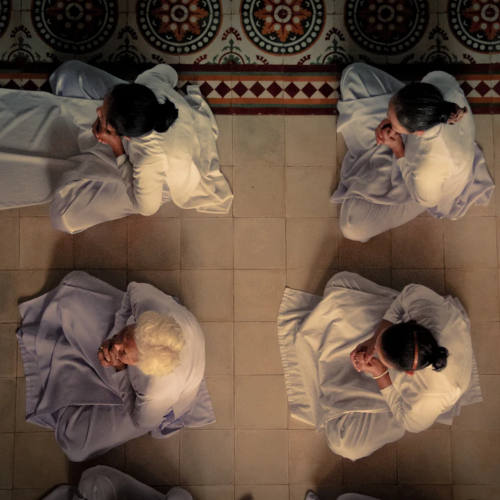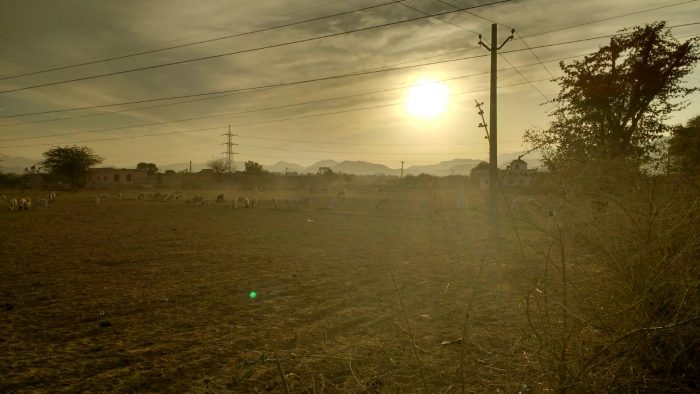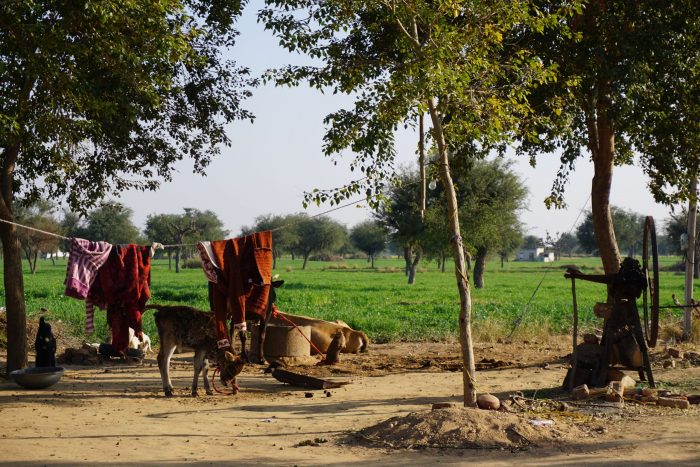I never expected that laughter would be part of the solution. I had set out on fieldwork with rather vague notions about the importance of sensitivity and silence when researching intimate stories of violence and loss. However, an unforeseen form of interaction would help me build trust with my interlocutors. In the midst of conversations about the most painful moments in their lives, my respondents seemed to find relief and agency in opportunities to laugh with me, and also frequently at me.
In the autumn of 2016, I arrived in North India to research a unique piece of legislation: the 1989 Scheduled Castes/Scheduled Tribes Prevention of Atrocities Act. The so-called Atrocities Act aims to prevent and punish violence against Dalits (ex-untouchables) and Adivasis (tribals) by members of upper castes and has polarized political opinion in India. Despite its historical importance as India’s only hate crime law, the social life of the Atrocities Act had not yet been subject to dedicated ethnographic enquiry.
How could I establish intimacy and trust without raising concerns that I might exploit vulnerabilities of already traumatized families?
I embarked on my research in Rajasthan, an Indian state that has consistently recorded exceptionally high of violence against Dalits in India, aiming to peek behind the curtain of statistics and conviction rates. How was the Atrocities Act experienced, perceived and mobilized by survivors of caste-based violence? To answer this question, I planned to trace how attacks on Dalits in Rajasthan were reported, investigated and eventually turned into cases in lower courts.
However, this goal gave rise to a complex ethical dilemma: As a European woman who moved around Dalit communities to learn about atrocity cases, how could I establish intimacy and trust without raising concerns that I might exploit vulnerabilities of already traumatized families? Though I had lived in India during much of my childhood and was always accompanied by local activists and members of affected communities during my research, I was anxious to ensure that people felt in charge of their own narratives. How could I communicate and write about atrocities without taking fragile stories of injury out of the hands of communities that had been marginalized and hurt repeatedly? How could I encounter survivors and ask to hear about their experiences without “feasting” on their stories and heightening the power differential between us (Chatterjee 2013)? A month into fieldwork, I – quite literally – stumbled across an unexpected answer.
The Buffalo Incident
On an unbearably hot day, I sat in a cool, shaded room inside a small cement house in Rajasthan’s Jhunjhunu district. Next to me, meticulously sewing a new sari blouse, was Rupa Devi, a forty-year-old mother of three who belonged to the Meghwal Dalit community. Rupa Devi’s husband had registered a complaint against four upper-caste men under the Atrocities Act. The men, who belonged to the high-ranking Rajput caste, had beaten up and seriously injured Rupa Devi’s two sons when they had demanded fair wages for the agricultural labour they performed on the Rajput fields. Subsequently, the Rajputs had vandalized Rupa Devi’s family home and insulted her in front of the entire village. That afternoon Rupa Devi openly spoke about the fear, anger and humiliation she had experienced. Soon we were joined by her mother-in-law and daughter. Together they talked.
‘We don’t really have buffaloes in Germany,’ I tried to explain, ‘plus I am not wearing my glasses.’
However, the women had not always been this open with me. In fact, I had gained their trust through a rather curious series of events. A week earlier, I had come to visit Rupa Devi’s family along with a local Dalit activist called Sonali. We wanted to learn about the dynamics behind the violence and understand the ongoing legal process the family was embroiled in. While Sonali as a local Dalit woman had immediately inspired trust, the family had been more hesitant to talk to me. Though I spoke Hindi fluently, I was less familiar with the local Marwari dialect and clearly looked like a foreigner. Rupa Devi later told me that she had feared I might tell her story in a way that would bring further shame to her family. Sensing the family’s discomfort upon our arrival and determined to let Sonali do her work, I had excused myself to use the bathroom. Unfortunately, I had misunderstood the directions Rupa Devi had given me. Having turned left instead of right, I suddenly found myself face to face with a giant water buffalo instead of a bathroom. Letting out an audible squeak, I tripped over a rope, flew through the air and landed firmly on my bottom in front of a giggling horde of children. As I recovered, I thought that the accident was unlikely to inspire much confidence in my research.
However, I was wrong. The ‘buffalo incident’, as the children quickly termed it, inspired a fair amount of ridicule. “We don’t really have buffaloes in Germany,” I tried to explain, “plus I am not wearing my glasses.” This defensive plea only caused more laughter. But it also broke the ice.
Sonali and I stayed with Rupa Devi’s family for a week. I spent a lot of time re-enacting the buffalo incident for the amusement of the children. Soon, I learned that it was precisely this willingness to show vulnerability and joke – often at my own expense – that convinced Rupa Devi that I was someone she could confide in. In a strange juxtaposition, I was only granted insight into the family’s painful feelings around the violence once they were able to stop thinking of me as a serious professional.
The day I watched Rupa Devi sew, she said something that struck me.
Ever since we were attacked, activists, politicians and NGO people swarm around wanting information. It makes us feel like everyone is talking about us even while we are in the room. So, I didn’t trust you at first. But that now we can talk to you like this, jokes and all, like family, it makes me feel like we are alike, like you are our daughter: that you will listen and not write something I don’t want. Because when we can joke with someone, it means they are one of us (apna) and we are no longer just a victim family (pidit pariwar) to a researcher.
Humour as Humanization?
I do not wish to make light of the suffering families like Rupa Devi have experienced. Nor am I here to advocate that every fieldworker should engage in slapstick comedy when trying to build intimate relationships. However, Rupa Devi’s statement highlighted something important: She wanted to retain agency over her story after disclosing it and to trust the person in whose hands she placed it. In her eyes, the buffalo incident had broken down the boundary and hierarchy between researcher and researched by giving her family an opportunity to laugh at an outsider who held the power to share her experience with the world. The incident had humanized me and exposed my vulnerabilities, which gave her family a new feeling of control. The fact that I had clearly shown that I could be laughed at and laughed with like a child allowed her to return to a role she was confident in: mother, care-taker, and teacher.
Anthropologists have often discussed how their own performances of folly can be productive in negotiating access and establishing ties of friendship in the field. German anthropologist Klaus Peter Koepping has praised anthropologists’ willingness to place themselves “at the disposal” (1987, 29) of their interlocutors, as a unique way to create conversations at eye-level. Meanwhile, recent anthropological scholarship has increasingly emphasized the need to write with respondents, rather than about them (e.g. Blasco and Hernandez 2020).
Vulnerability and humour on part of the ethnographer can engender a sense of shared humanity.
Though rarely discussed in this context, I have often thought that such insights are especially relevant for debates about respectful ways to understand violence, trauma and marginality through ethnographic engagement. Commonly, anthropological accounts have revealed how brutality and suffering create relational trauma, which throws social interaction into question, and leads to a loss of voice (Robben et al. 2000; Lester 2013). Efforts to elicit narratives of violent events from survivors, therefore, creates the potential for re-traumatization (Mulla 2014). Consequently, anthropologists have proposed that ethnographers should impart a sense of agency and relief through the very act of listening (Das 1990; Gupta, Bhattacharya and Priya 2019): Listening, Richard Burghart writes, “transforms” both listener and speaker, whose full humanity is acknowledged by being heard (2008, 300). Silent acts to hearing, thus, allow ethnographers to grasp the meaning and effects of violence (Kidron 2009).
However, Rupa Devi’s words highlight something that goes beyond the mutual respect and acknowledgment imparted though silence and listening. By emphasising that my willingness to be joked with made me ‘one of them,’ she showed that vulnerability and humour on part of the ethnographer can engender a sense of shared humanity and lead to interactions that feel socially ‘normal’ and more equal.
Taking a Joke
Rupa Devi’s daughter told me that my (un-)intentional performances of imperfection, and the laughter it inspired, convinced her there was a mutual willingness to drop defences: “You falling down, and us laughing about it, showed me that you were still learning about our life and unsure of yourself,” she said, “so we understood that you weren’t some big foreign Madam. And that you were playing with the children and acting it out for them like a big sister, that was really nice!”
And as one of them, I could be trusted with their pain.
The way I chose to handle the buffalo incident and the ensuing ridicule indicated to the women that I was here at their ‘disposal,’ to be instructed on local life and to be interacted with as a person willing to learn. Letting the children laugh at me revealed a willingness to be part of a family. This insight gave Rupa Devi a sense of control over her narrative as it travelled out into the world. By letting the family poke fun at my expense, I had given myself to them in a way that made me theirs. And as one of them, I could be trusted with their pain.
Making a Joke
Rupa Devi also stressed that her family could laugh with me. During my time with the family, I not only learned how to take a joke, but also how to make one in return. Hesitant at first, considering my role as a visitor and the family’s painful recent history, I soon realized that the family appreciated banter and mutual teasing. It entertained them, provided relief and a sense of normalcy, while reinforcing the idea that I was not separate from them. At the most difficult time of their lives our attempts at shared humour created a sense of mutuality: they hinted at a potential for equality, which would not have arisen otherwise.
Though anthropological studies of humour as a cultural practice and as a methodological tool are limited, scholars have explicitly acknowledged its power to build rapport and trust (Swinkels and de Konig 2016). While humour can be one of the most difficult cultural practices for anthropologists to grasp, and engage in, once mastered, it forms the strongest bonds of intimacy. Eva van Roekel’s work in Argentina highlights how ‘laughing together’ allows ethnographers to better access and understand hidden meanings in post-conflict settings (2016).
Vulnerable Conclusions
My fieldwork with survivors of caste atrocities in Rajasthan revealed that, above all, many survivors wanted to be engaged with as three-dimensional interlocutors – people with history, emotion and agency – and not simply ‘victim families’. However, my respondents also taught me something more.
When ethnographic vulnerability becomes a medium for humour, it can do something anthropologists of violence have often struggled to accomplish. It can give survivors a new sense of control by reducing professional distance, while simultaneously providing a moment of escape for both sufferer and researcher.
This is neither an easy nor entirely comfortable insight, and raises a number of new questions: How can humour be used sensitively and productively during fieldwork? How can ethnographers engage in humour respectfully to create agency, rather than to limit it? Humour taken too far can demean and heighten power differentials rather than reducing them. How can ethnographers walk the line?
Laughter can mask suffering and painful reality, while simultaneously representing an orientation towards hope.
As someone whose background often makes me both insider and outsider in India, I am inclined to propose an openness towards humour, and a conscious preparedness to embrace opportunities for joking and laughter when interlocutors offer them. I don’t believe that humour can, or should be, used strategically in anthropological research. Doing so would defeat the organic power of connection that inheres in humoristic practices and shared laughter. However, after almost two years of fieldwork on caste-based atrocities I am, nonetheless, here to make a case for ethnographic vulnerability and humour as a way to foster feelings of agency in interlocutors, who are anxious to maintain jurisdiction over personal stories after violent rupture: a joke, silliness, a willingness to be laughed at, or even moments of teasing and poking fun can be sensitive ways to build connections.
However, rather than proposing an active ethnographic mission to use humour, I believe that we should endeavour to actively learn to recognize opportunities and moments when we might receive and return it. In the aftermath of violence laughter can mask suffering and painful reality, while simultaneously representing an orientation towards hope; anticipation of the return of joy (Smith Bowen 1964). As anthropologists we should find a way to be part of that.
Toni, a teenage Dalit girl whose family had been attacked by upper caste men following a land dispute, provides a fitting conclusion to these reflections:
‘My family likes joking about the things you say and do sometimes. It is nice to laugh and to feel like we get to observe somebody who is here to write about our lives. It means we aren’t always the one being looked at and we are more than the atrocity.’
Podcast
[separator type=”space”]References
Blasco, Paloma Gay y and Linda Hernandez. 2019. Writing Friendship: A Reciprocal Ethnography. London: Palgrave MacMillan
Burghart, Richard. 2008. The Conditions of Listening: The Everyday Experience of Politics in Nepal, in: C.J. Fuller and Jonathan Spencer (eds.), The Conditions of Listening: Essays on Religion, History and Politics in South Asia. New Delhi: Oxford University Press, 300–318.
Chatterjee, Moyukh. 2013. “Modes of Encountering the Survivor of Violence.” Contributed Content: Society for Cultural Anthropology. American Anthropological Association. https://culanth.org/fieldsights/modes-of-encountering-the-survivor-of-violence.
Das, Veena. 1990. Our Work to Cry: Your Work to Listen. In Das, Veena (ed.), Mirrors of Violence: Communities, Riots and Survivors in South Asia. New Delhi: Oxford University Press, 345–399.
Gupta Arpita, Bhattacharya Prama, and Priya Kukar Rani. 2019. Revisiting the Paradigm Shift in Trauma Studies: Twenty-Five Years of Veena Das’ ‘Our Work to Cry: Your Work to Listen.’ Journal of the Anthropological Survey of India. 68 (1): 70-84.
Kidron, Carol 2009. Towards an Ethnography of Silence: The lived Presence of the Past in Everyday Life of Holocaust Trauma Survivors and their Descendants in Israel. Current Anthropology 50 (1):5-26.
Köpping, Klaus-Peter. 1987. Authentizität als Selbstfindung durch den Anderen: Ethnologie zwischen Engagement und Reflexion, zwischen Leben und Wissenschaft, in: Hans Peter Duerr (ed.), Betrug in der Ethnologie, Frankfurt/Main: Suhrkamp, pp. 7-37.
Lester, Rebecca. 2013. Back from the Edge of Existence: A Critical Anthropology of Trauma. Transcultural Psychiatry 50 (5): 753–762.
Mulla, Sameena. 2014. The Violence of Care: Rape Victims, Forensic Nurses, and Sexual Assault Intervention. New York: New York University Press.
Robben, Antonius C. G. M. and Suárez-Orozco, Marcelo M. (eds.). 2000. Cultures under Siege: Collective Violence and Trauma. Cambridge: Cambridge University Press.
Scarry. Elaine. 1985. The Body in Pain: The Making and Unmaking of the World. New York: Oxford University Press.
Smith Bowen, Elenore. 1964. Return to Laughter: An Anthropological Novel. New York City: Double Day.
Swinkels, Michiel and de Konig, Anouk. 2016. Introduction: Humour and anthropology. Ethnofoor 28 (1): 7-10.
Van Roekel, Eva. 2016. Uncomfortable Laughter: Reflections on Violence, Humour and Immorality in Argentina. Etnofoor 28 (1): 55-74.
Featured image (cropped) by Kevin Bluer on Unsplash.








